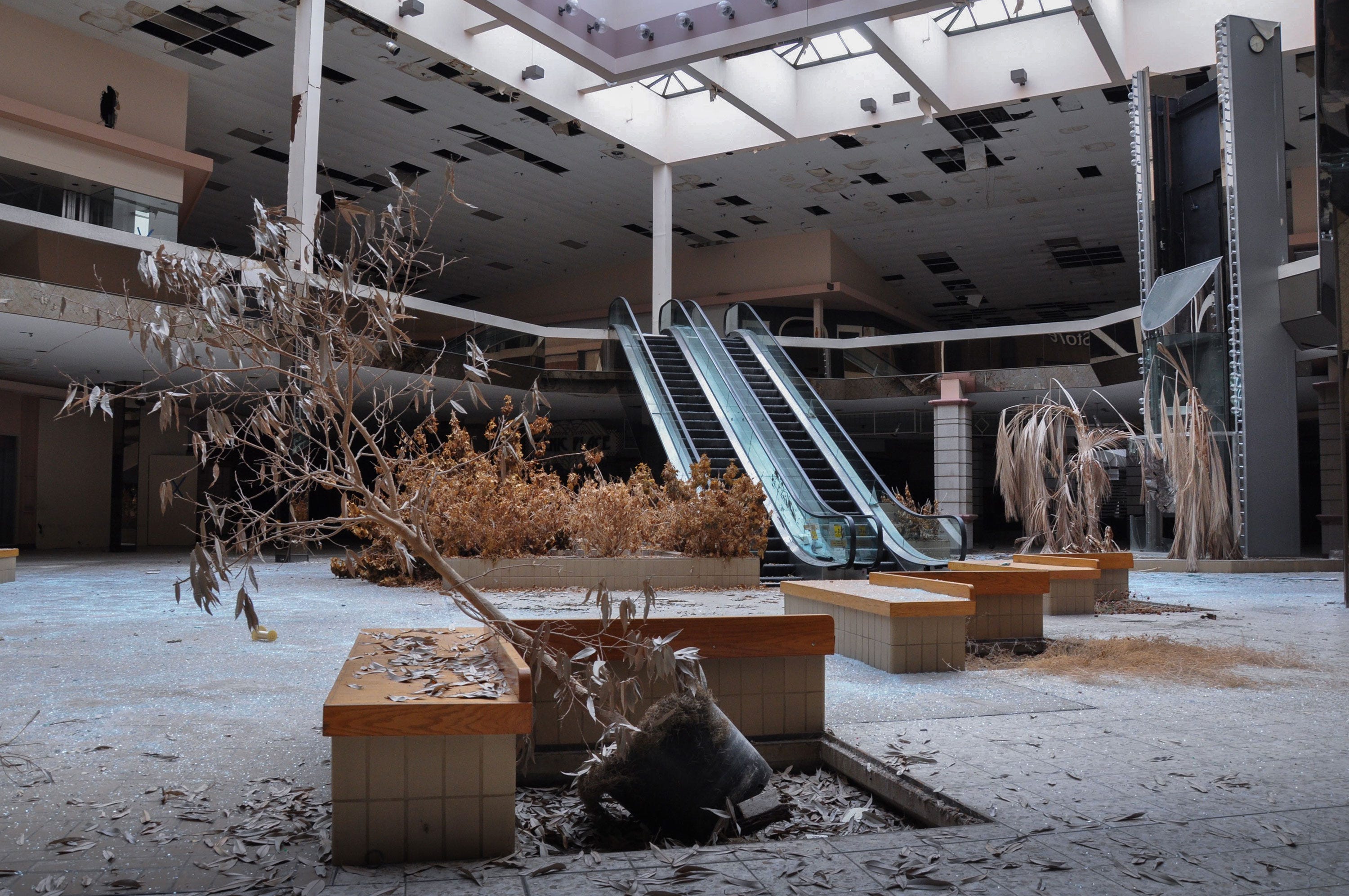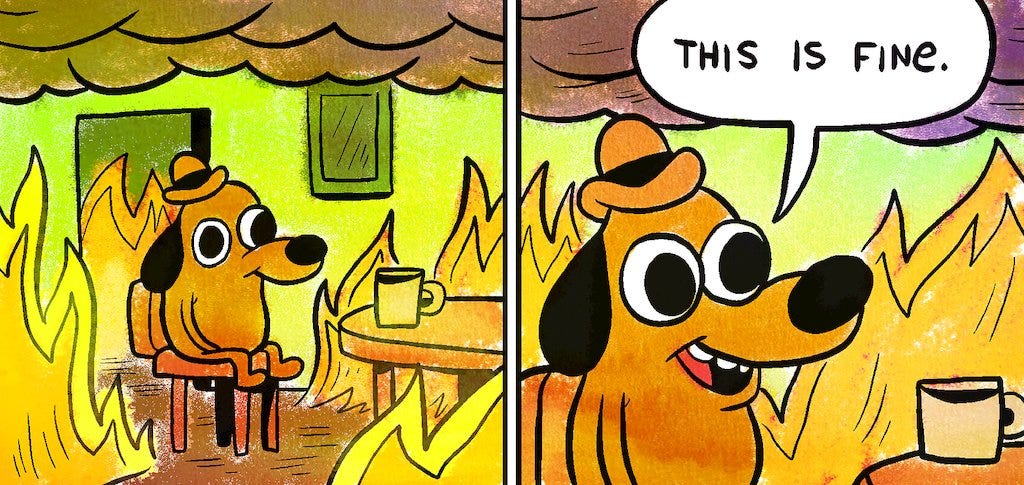Become Weeds: Shatter Their Pavements

As we enter the “waiting for the other shoe to drop” phase of the crisis—which can last anywhere from a couple weeks (my guess) to a few months, as it appears relatively clear that the total and full collapse was put off by the Credit Suisse merger and the weekslong belief that the Fed would in fact backstop all deposits (Janet Yellen told the Senate yesterday that the FDIC would not do that, but it was done late enough in the trading day to keep from turning into a total rout) prevented the full banking system collapse from happening instantaneously
Now that it’s just a waiting game, and the belly laughs at these man-babies licking pavement are delayed, time for us to pivot toward what the hell any of this means for us proles. To answer that, we’re gonna have to look at where the fracture points are in the collapse ahead. This will be necessarily speculative, but hopefully I can provide some ideas for you to chew on. This post is also focused on particular sectors of the economy as financial assets, rather than labor and labor costs.
Find the Bubble
During the last crisis, the bubble that popped was built around elaborate financial deals made out of combining a whole lot of bullshit mortgages. Poor people—disproportionately Black and hispanic, and overwhelmingly in rural, suburban sprawl and exurban areas—were given terrible variable rate loans by a class of absolute scum bags who knew that no matter how low the likelihood of each particular mortgage actually being paid was, and how likely such a bad mortgage would ruin the lives of their ‘clients’, they could sell the mortgage up the chain to massive banks, who would then slice and dice them into a variety of financial instruments—Collatoralized Debt Obligations (CDOs) being the most infamous.
The ratings agencies would then declare these instruments made up of terrible exploitative mortgages AAA prime beautiful assets. They would be marketed by the bankers as safe as cash, to mutual funds, pension funds, city governments and the other massive but risk-averse clients who thought they were basically getting higher-yield savings accounts. As long as the housing market went up, the value of these assets did too, and even if a few mortgage payments didn’t come in, each CDO was built out of so many different mortgages that the effect was negligible…until it wasnt.
When enough of these mortgages—many of them given without the mortgage company so much as verifying the employment, let alone the actual income or debt, of the applicant, and most of which featured such aggresively harsh rate changes and penalties that even people with good income and credit got absolutely fucked—went underwater, and stopped being paid, the whole house of cards went down.
But the thing was, the asset class that caused the crisis was mostly cheaply built new housing units in sprawling hinterland developments in e.g. Central Florida or Western Ohio, which meant the sites of the crisis were either bank hqs or spread far and wide, with the victims fairly isolated politically and geographically. Even if we had had anything remotely close to the movement infrastructure we have now—and we had nothing at all like it—it would have been hard to organize around these hyper-individualized sites of disaster. But the state of our movements is much stronger in 2023, and the sites of potential collapse much more potent for our moves.
So where is the collapse going to come from? Which asset class is going to fall?

Crytpo
As I have consistently maintained, crypto is the funniest possible vector of economic ill health since the Dutch tulip craze, made up as it is of the least charismatic grifters yelling at each other in Discord chats about how revolutionary jpegs are, but from my vantage this could only ever be a domino falling over. Crypto was never central enough nor widespread enough to really bring everything down. Even with the last week’s dead cat bounce, doesn’t really seem like Crypto can offer anything other than a collapse catalyst. If I’m wrong on this one, tho, and institutional finance is actually fully leveraged in the crypto space? LOLOLOL.

Retail
Retail was already in serious crisis even before the pandemic started. “Brick and mortar retail, you mean?” Nope. Amazon may have disrupted retail so severely that even Walmart thought it was unfair, but Amazon’s massive store at this point is just a loss-leader for Amazon’s web and financial services, which are the only actual profit drivers at the company.
Amazon has been making dramatic workforce cuts in the last few weeks, because Amazon was, like the rest of the retail tech world, a business mostly maintained by burning cash to drive down wages and drive out competition. But once Amazon achieved dominance, it realized with dawning horror there’s no there there.
The vast VAST majority of consumption is done by the richest Americans; meanwhile the bottom 50% of Americans spend almost all their money on housing, transportation, and food. So if you’re offering non-essential consumption, your market is really only the top 20% of wealth. So the race to the bottom for cheap retailers (Amazon, Walmart, Dollar General etc) is a big market nominally but doesn’t actually offer a lot of space for growth or competition.
Amazon actually can’t hike prices enough to make profits, because then people won’t use it anymore, because people don’t actually have any money, because wages have been steadily suppressed for almost five decades now. So if you’re not offering consumption the the upper middle class, you’re ultimately in a losing game.
There are a few store brands we know that are almost certainly doomed—Bed Bath and Beyond, Gamestop, AMC theaters, Macy’s, Sweetgreen, Shake Shack, Peloton, Freshpet, Carvana are all companies that have been on over-valuation death watch for at least two years. Tesla should probably be added to that list—and it will be another hilarious historical irony that in March 2023, two ratings agencies upgraded Elon Musk’s car recall business to the status of a Blue Chip.
But beyond getting some swag on the deepest of clearance prices when the staff doesn’t give a fuck if you just saunter out of their stores with merchandise, this doesn’t seem to offer a lot of opportunities for struggle. And the collapse doesn't look likely to spread from retail brands going down, as retail has long been in a series of boom and bust cycles and the broader system is relatively protected from retail crises, though it will cause a lot of economic pain.

Big Tech
It is almost certain that a huge swath of the tech economy is in for some “disruption”. Musk may be able to light his own bank account on fire long enough to keep Twitter bumbling along, and while Meta (Facebook) and Alphabet (Google) are looking increasingly shaky as they still haven’t really figured out a way to turn the most elaborate surveillance aparatuses since the invention of God into steady revenue, they’ll probably make it through. Even Apple has seen diminishing returns from the collapse of Moore’s Law, but isn’t yet in crisis. Rest In Piss, however, to Snap, Flickr, Pinterest and the rest of the second tier web 2.0 also rans.
But if we look a little further down the food chain, it seems absolutely certain that services like Uber, Fiver, DoorDash, Lyft and all the other consumer apps are fucking doomed. Uber hasn’t managed to turn a profit despite their names literally becoming a verb unto itself, ala Xerox or Bandaid, and now that VC capital is well and truly dead there are no more piles of cash for them to drop into a paper shredder. With any luck well be able to add AirBnB and VRBO to this list.
But these services are already designed around alienation and isolation—that’s how they drove down prices, after all, by utterly shattering any sense of work force solidarity or even the very concept of employees. You can’t go on strike against an app that is out of money.
However, here I see the openings for the first strategic interventions. These apps, particularly in ride share, food delivery and labor have fully taken over our urban spaces and our modes of daily reproduction. Can we begin to reconceptualize these modes of daily life outside of capital, either in its new app mode or in its old form (delivery drivers, taxi cabs, hotels and temp agencies) and pivot toward using bottom-up tech driven modes of mutual aid? Like Uber, but for anarchy!
There are going to be real material crises ahead if these companies collapse, and real needs that, if we begin planning and thinking now, we will be able to meet communally. After all, isn’t that just what those apps did: turn people’s vehicles, homes, bodies, time and effort into things other people wanted? What if instead of relying on the mediation of electricity, cash and algorithms to summon strangers to our aid, we helped our neighbors do the things they need to do? It might seem like a stretch but the Montgomery Bus Boycott was won by black folks in Montgomery organizing elaborately scheduled carpools, ride shares, baby sitting and other forms of mutual aid for almost an entire year. And in the General Strike of 1919 in Seattle strikers literally delivered food and milk to the entire city.
But much like crypto, it doesn't seem to me like tech is going to be at the center of the bubble. If VC tech collapsed alone, the current crisis would actually be containable to SVB and First Republic, as the paragons of economics-knowing kept insisting.

Commercial Real Estate
But now we get to the market where the real pain is, and the real opportunities. Because commercial real estate, particularly office buildings, are likely to spark a real deep financial crisis. And to do that we’re gonna have to understand how the mortgage business works, and in particular how “underwater” mortgages work and how the health of the real estate market is measured.
[If this kind of stuff makes your eyes glaze over feel free to jump down a few paragraphs to where I talk about what this all means. If you love a good wonky and in-the-weeds view of the current state of the market, check out the most recent episode “Where Stress is Showing in the $20 Trillion Commercial Real Estate Market” from Odd Lots podcast.]
An underwater mortgage is a situation in which the loan you took out to pay for a property is more expensive than the value of the property. This is a problem because, if you were for some reason to want to move out of a house or get rid of a building you own, you can usually just sell it, cover the mortgage, and move on. But if the building is worth less than the amount you still own on the purchase , then you’re trapped. And if you can’t make mortgage payments, rather than sell and move somewhere cheaper, you are going to default on the mortgage, possibly have to declare bankruptcy, and lose everything to the bank that has the loan, which will take the building back.
Real estate investors, bankers and economists developed a handy-dandy ratio to measure the health of a property’s mortgage status, the Loan-to-Value ratio, or LTV. The lower your LTV, the better shape your property value is in. LTV is often described as a percentage. If the LTV goes over 1, or 100%, however, you are officially underwater.
Why explain all this? Because the current average LTV for all of America’s malls is 90-95%, which is to say, most malls are either on the edge of or entirely underwater. But malls have been in a long on-going secular decline, and the mallpocalypse is pretty much integrated into financial outlooks moving forward.
What isn’t as well priced in, however, is office buildings. Office space supply was already significantly inflated before the COVID crisis, as free money from the Fed and real estate line-goes-up myopia meant that office building funding could always be found (look at the skyline changes for any major or mid-sized city in America over the last ten years). This construction boom in the US and Europe was just a shadow of the boom in China, but there were already troubling signs of vacancy before the emergence of normalized work-from-home through the last three years.
The 2019 collapse of WeWork was a combination of the VC/Tech bubble and the commercial real estate bubble, and might end up being a sign of what’s coming.
As my friend Mia pointed out, this explains the sudden glut of think pieces about how much work from home sucks—if office space doesn’t get filled up again soon, firms wont be able to roll over, refinance or pay for their construction and purchase loans that are gonna start coming due this year. This will lead to a lot of commercial real estate companies going bust, and the vast majority of those loans are held by regional banks of the size of SVB, which might also collapse. In the otherwise utterly uninformative Fed meeting press conference yesterday, the only question asked to chairman Jay Powell that wasn’t either about the financial crisis or the future of interest rate hikes was about commercial real estate. Powell dismissed these concerns out of hand.
Maybe he’s right, and the banks will survive these deals defaulting. I fucking doubt it, but even if he is, it does mean there are going to be a lot of empty mall, retail and office buildings all over the country, particularly in expensive downtown cores. And while it is very expensive to legally transform office building into residential, it is not nearly as hard to transform it into at the very least temporary housing, well, actually. And if activists can map and figure out where these abandoned properties are, it’s possible that the commercial real estate crisis could offer an effective (if temporary) solution to the homelessness crisis.
The Everything Bubble
While one class of assets overwhelmingly drove the 2008 crisis, it may in fact be the case that regulators, the fed and Dodd-Frank did enough to prevent that exact scenario from happening again. The predatory mortgage lenders from 2008 took over foreclosed houses and turned them into rental properties, and then built rent-backed-securities looking eerily like CDOs on top of them, but they may not be crucial enough to the financial sector to cause another 2008. The housing market is showing serious slow down, with refinancing more or less stopping entirely and housing purchases collapsing, because incredibly high mortgage rates are deeply unattractive. But banks are not totally leveraged around “real estate line goes up” as they were in the 2000s.
But what if real estate, commercial real estate, tech, retail and (lol) crypto were to go down at once? What if the economy was to face stagflation, rising cash costs, the end of the Chinese construction boom backstop, and, say, a significant drop in energy prices?
In other words, what if the financial sector diversified its rampant gambling, asset bubble building strategies and magical thinking to the entire economy at once, over 15 years, with the goal of never being so vulnerable to one single bubble that the entire financial system became one giant bubble?
No no no, that can’t be the case. The rate of profit may literally never have recovered from 1973, but you don’t need a rate of profit to be high for capitalism to flourish. Everything is fine.

But in case it isn’t, there are going to be huge swathes of territory, physical territory, abandoned by capital. Turning empty hospitals into community mutual aid centers, bankrupted multiplexes into proletarian pleasure palaces, office buildings into swanky unhoused encampments—these are all things that will be possible in the years to come, as long as we stay on the attack.
When we fight the police in the street we know to be water. Let’s also grow like weeds in the cracks of their system, and turn their pavement into flowers, gardens, and eventually, forests.
